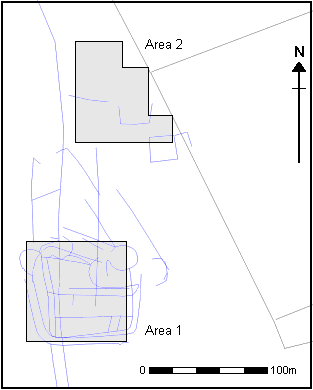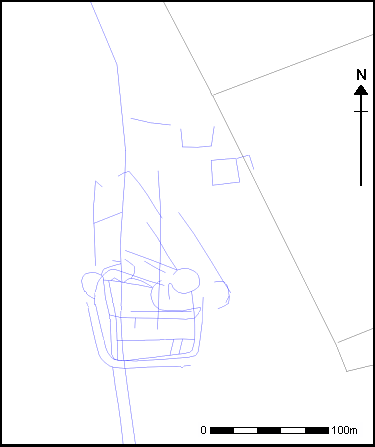
The geophysical survey was carried out between October and December 1994. The aim of the survey was to produce a detailed map of sub-surface geophysical anomalies within the sites as defined through aerial photography. The survey was also to act as a pilot study to assess the relative effectiveness of magnetic and soil resistance techniques in mapping anomalies in this area.
Figure 31: Location of Geophysical Surveys

Two survey areas (see figure 31) were located in the northern part of the large field to the west of Burrow House Farm. Area 1 (NGR 49760 46674) was situated over the central and eastern part of the concentration of cropmarks (SMR 6868) forming a large enclosure with several associated smaller enclosures. Area 2 (NGR 49763 46690) was sited over two small sub-rectangular enclosures to the north-east of the larger crop-mark site. Both areas were subsequently examined by excavation.
The results of the magnetometer survey are shown as a two-dimensional grey-scale plot. The results of the soil resistance survey are also shown. A map has been made of features considered to be archaeological from both the magnetometer and soil resistance surveys. The results of both surveys were dominated by three north-south linear anomalies, two apparently representing ditches related to the enclosure, whilst correlation with the aerial photographs indicated that the third represented the sunken trackway. The central north-south anomaly divides into two narrower ditches and turns east, apparently continuing to form the northern edge of the large sub-rectangular enclosure observed on the aerial photographs. Unlike the magnetometer survey, the soil resistance survey clearly shows an arm of this ditch also continuing north to the edge of the survey area. The reason for this discrepancy may be due to the backfill of the ditch in the area containing less magnetically enhanced material such as topsoil and occupation debris.
The weak east-west linear feature present in the southern part of both the magnetometer and soil resistance plots may indicate a sub-division within the main enclosure. Two large sub-circular anomalies are present in the northern part of the survey area. These may represent smaller associated enclosures, or they may mark the outline of ploughed-out round barrows. The soil resistance survey shows high soil resistance on the interior of the north-eastern feature, suggesting the presence of compacted soil at the base of the ploughsoil.
The interior of the large enclosure contains many magnetic anomalies in the form of linear and curvilinear features as well as more discrete anomalies which are likely to represent pits. This contrast in feature density between the interior of the large enclosure and the interiors of the sub-circular features may indicate that the larger enclosure defined human occupation, while the smaller enclosures were either related to animal husbandry, or were burial features.
As high-resolution magnetometry had proved to be the most effective technique in mapping archaeological features in Area 1 this was the only technique applied in Area 2. The results of the survey are shown as a two-dimensional grey-scale image plot. A feature map of anomalies considered to be archaeological has also been made.
Although Area 2 was situated over a simpler complex of cropmarks compared to Area 1, the results of the magnetometer survey produced a feature map of equal density and complexity. The survey identified a group of sub-rectangular enclosures with possible entrances. A large number of narrower linear and curvilinear features as well as pit and posthole type features were also defined.
It is not clear from the results of the survey whether these enclosures were contemporary or represent a sequence of separate phases superimposed upon each other. The presence of possible entrances and the distribution of internal features would suggest that this is a similar type of settlement site to that defined in Area 1.
The south-eastern corner of the survey area contained many small strong anomalies characteristic of ferrous debris. The activity is more likely to relate to modern agriculture, as it is concentrated along an existing field boundary, or to the existence of a prisoner of war camp on the other side of the boundary during World War II.
Although high resolution magnetometry proved itself to be the most effective technique in mapping sub-surface archaeological remains, the results of the soil resistance survey clearly provide valuable complementary information on variations in soil compaction as well as identifying features with non-magnetic backfills. The survey provided detailed maps of two sites coarsely defined through aerial photography (see figure 32). The results also indicate basic zonation within these sites based on feature density and variations in soil compaction.
Figure 32: Crop-marks showing Cottam B in relation to the modern field boundaries

© Internet Archaeology
URL: http://intarch.ac.uk/journal/issue10/richards/geophys.html
Last updated: Tue May 15 2001